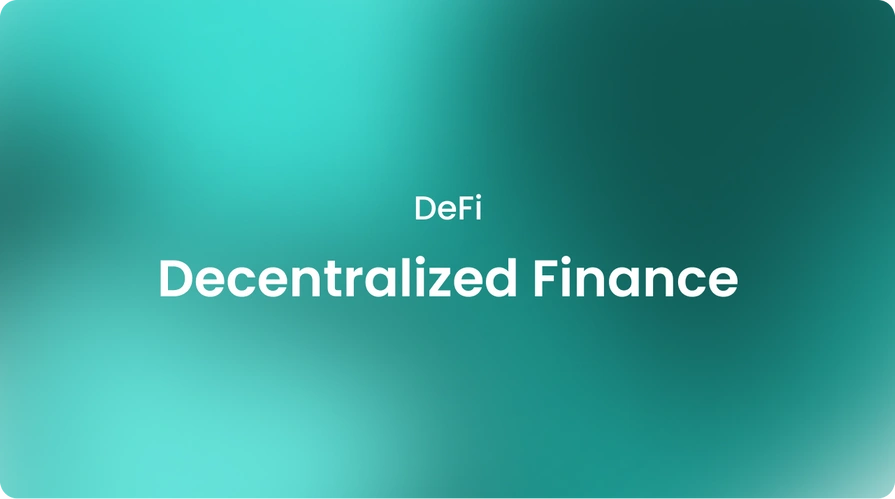|crypto, knowledgehub
What Is Crypto Lending?

The act of borrowing and lending cryptocurrencies is known as crypto lending. It allows crypto holders to earn interest on their digital assets by lending them to borrowers, similar to how traditional bank lending works.
Crypto lending provides opportunities for both investors and borrowers in the growing digital currency space. Join us in this blog as we explore crypto lending, how it works, safety, profitability, how to lend crypto, and more. Let’s start!
Crypto lending platforms act as intermediaries, facilitating lending between borrowers and lenders. Lenders deposit their crypto assets on the platform and earn interest on them.
The platform then lends these deposited assets to borrowers, who pay interest on the loans. The original lenders receive this interest, deducted from the platform's fees.
For example, if a lender deposits 1 ETH onto a crypto lending platform, the platform may lend that ETH to multiple borrowers. After deducting the platform's fees, the borrowers accumulate and pay weekly or monthly interest to the original ETH lender.
Some platforms also offer other crypto lending products, like crypto loans, where borrowers post collateral in excess of the loans.
Crypto lending for borrowers
Borrowers are typically traders who want leverage to execute larger trades, make speculative bets, or gain leveraged exposure to other crypto assets without liquidating their current holdings. Some may also take out instant crypto loans for personal needs.
To reduce risk and provide incentives for repayment, most platforms require borrowers to over-collateralize their loans with 110–150% of the borrowed amount in alternative cryptocurrencies.
Crypto lending for investors
For investors, lending their crypto out passively generates ongoing interest income without the need to actively trade. Interest rates often range from 6–15% annually, depending on the cryptocurrency, compared to less than 4% on savings accounts.
This allows holders to earn income from their cryptocurrency holdings instead of being unproductive. Furthermore, crypto lending protocols provide capital protection because their smart contract controls the collateral, not the borrower.
What are the pros and cons of crypto lending?
Crypto lending provides an additional income opportunity beyond just holding or trading cryptocurrencies. It introduces the ability to earn interest, similar to a savings account but with much higher yields.
However, lending comes with credit and smart contract risks, since defaults are possible if collateral prices suddenly drop or in the event of a hack. Platforms also face regulatory risks.
Is crypto lending a good idea?
For risk-averse investors, platforms that provide FDIC insurance on USD deposits and strictly audited reserves for stablecoins mitigate much of the crypto lending risk. Their lending rates are still significantly higher than those of traditional savings accounts.
Moreover, crypto lending is a good idea for believers in long-term crypto adoption, as the high interest helps cost-average buy more coins over time.
By providing liquidity and capital to traders and businesses, cryptocurrency lending spurs greater cryptocurrency utility and adoption. It allows users to gain leveraged exposure via crypto loans while still maintaining ownership of their assets.
For lenders, stable interest incomes provide better returns than holding cash in a bank. P2P crypto lending networks also help bypass rigid banking regulations around the world.
Is crypto lending safe?
There are never any guarantees in the crypto world, but some platforms are inherently safer than others. Lower-risk options include more established companies like Cryptobunq, which provide insurance on fiat deposits, keep the majority of assets in cold storage, and have robust risk management procedures.
Cryptobunq is an expert one-stop-shop crypto service provider in this regard. On CBQ, you can find a crypto exchange API, crypto checkout and invoicing, batch crypto payments, custody and wallet, and other solutions. If you want to explore further, make sure to check out our case studies!
Lending protocols with overcollateralized loans and automated liquidations also provide greater safety than exchanges with loose lending practices and poor security. As with all crypto products, one can only allocate funds they can afford to lose when lending crypto.
Why not consider cryptocurrency lending?
While high-yield opportunities are attractive, there are certain risks that individuals averse to volatility should avoid. In many countries, platforms are largely unregulated, with no deposit protections. Bugs could occur in smart contracts, or hackers could compromise the platforms and steal funds.
There is also little recourse for borrower defaults apart from liquidating over collateral. These risks are exacerbated in the case of a severe crypto winter, when prices and collateral values substantially drop together. Such financial conditions increase losses collectively.
How risky is crypto lending?
While crypto lending offers far higher yields than traditional banking, the risks are also greater compared to bank deposits. The main risks are smart contract exploits, platform hacks, borrower defaults during severe market crashes, and a lack of regulations.
Always do thorough due diligence on platforms, and only lend crypto what one can afford to lose entirely for maximum risk management and portfolio diversification. Borrowing against crypto collateral also comes with crypto liquidation risks if collateral prices suddenly drop below the loan-to-value ratio.
Is crypto lending profitable?
When lent on well-capitalized platforms during stable market conditions, crypto lending has historically proven profitable for lenders. Annual lending yields often range between 6 and 15% on mainstream cryptocurrencies. Check out “Yield Farming” to explore more!
Meanwhile, stablecoins offer lower but more predictable returns, as high as 8–10% crypto APY on platforms. These returns far surpass bank savings accounts and even outperform stock market indexes in many previous years.
However, past performance is not indicative of future profitability due to the volatile nature of crypto markets and hacking risks.
What is the difference between lending and staking crypto?
Some key differences between lending and staking crypto are:
- Lending earns interest by matching borrowers and lenders, while crypto staking earns rewards by assisting in transaction validation on proof-of-stake blockchains.
- Lending rates vary depending on market supply and demand, while staking rates tend to stay relatively fixed by protocols.
- Crypto lending poses the risk of principal loss if borrowers default, while staked funds remain fully under user control on supporting wallets.
- For those wanting guaranteed yields with minimum risk, staking large-cap crypto may represent a safer avenue than uncollateralized lending involving third parties.
How to find the best crypto lending rates?
To maximize returns, focus on crypto lending platforms offering competitive interest rates in stable lending markets. Investigate rate histories and check for fluctuations caused by supply and demand changes.
Diversify across blue-chip protocols for reduced counterparty risk. Given volatility risks, keep prudent collateral thresholds well above crypto liquidation levels.
How to select a crypto lending platform?
When choosing where to participate in crypto lending, focus on regulated and transparent platforms with insurance for crypto custody reserves to protect deposits. Think about platforms that have undergone full market cycles of stress testing.
Ensure a track record of responsible smart contract development and code audits. Compare lending terms, supported assets, loan types, loan-to-value ratios, liquidation procedures, and interest rates.
Additionally, it is important to research insurance providers for robust collateral coverage to mitigate losses in the event of a market downturn.
How to lend crypto?
- Register for a crypto lending service.
- Deposit your cryptocurrency and review the available interest rates.
- Choose your crypto loan terms, collateralization ratios, and auto-renewal settings.
- Lend your deposited assets and start earning daily compound interest.
- After the term ends, withdraw your original currency plus any interest.
- Be cautious when managing risk due to market changes, and consider diversifying your asset holdings.
With prudent risk management and research practices, crypto lending offers participation in the financial revolution of decentralized blockchain-enabled lending, benefiting both borrowers and lenders globally.
The bottom line
In innovative new ways, crypto lending presents opportunities for yield generation and access to capital. As regulatory frameworks evolve and the industry continues to advance security standards, it could significantly expand the reach of decentralized finance (DeFi).
However, it also carries risks, given market volatility and the lack of insurance protections in some cases. For believers in cryptocurrency and its long-term prospects, approaches like lending small amounts on regulated platforms may represent a smart risk.
Crypto lending, with proper due diligence, has the potential to be used for cross-border remittances, payments, and financing the needs of both individuals and businesses.
If you need a secure partner to grow your crypto projects, Cryptobunq is here to help. You can easily integrate our solutions into your projects and take advantage of tailored solutions. Contact us today and find out the advantages CBQ offers!













